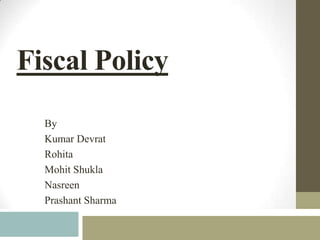
Fiscal deficit
- 1. Fiscal Policy By Kumar Devrat Rohita Mohit Shukla Nasreen Prashant Sharma
- 2. What is Fiscal Policy? • Fiscal policy involves the Government changing the levels of Taxation and Govt Spending in order to influence Aggregate Demand (AD) and therefore the level of economic activity. • AD is the total level of planned expenditure in an economy • C- is consumption , • I- is Investment, • G- is Government spending, • X- is total exports, and • M- is total imports AD = C+ I + G + X – M
- 3. Reasons for Fiscal deficit Increase in Subsidies Unproductive Payment of expenditure by Interest the government Defense Huge Borrowings Expenditure Poor Weak Revenue Performance of Mobilization Public Sector 3 Tax Evasion
- 4. Objectives Of Fiscal Policies Increase in capital Achieve formation desirable employment level Achieve desirable Achieve income desirable distribution price Achieve level desirable consumption level 4
- 5. Types Of Fiscal policies Expansionary Fiscal Policy Contractionary Fiscal Policy 5
- 6. Expansionary Policy / Loose Involves increasing AD Govt will increase spending (G) & Cut Taxes Lower taxes will increase consumers spending because they have more disposable income(C) This will worsen the govt budget deficit Risk of High Inflation due to huge demand & increase in money supply
- 7. Contractionary Policy / Tight Involves decreasing AD Govt will cut spending (G) & Increase Taxes High taxes will decrease consumers spending because they have less disposable income(C) This will help in improving the govt budget deficit Not Easy to achieve this
- 8. Balancing Economy Automatic Fiscal Stabilizer Discretionary Fiscal Policy 8
- 9. Tools Of Fiscal Policies Public Expenditure Income Of The Government Government Borrowings 9
- 10. Fiscal Responsibility And Budget Management (FRBM) • Long-term macroeconomic stability FRBM • Reducing revenue deficit FRBM • Reducing the Public debt FRBM • No Borrowing from the RBI FRBM
- 11. Criticisms of Fiscal Policy Disincentives of Tax Cuts. Poor Crowding Informati out on Time lags
- 12. Implications of Fiscal policy • It will lead to capital infrastructure like higher education, growth and output. • It help and facilitate trade and promote economic activity in the private sector. • It will build up the framework for strong economic growth and working towards full employment. • It will improve and promote in economic development.
- 13. IS-LM Curve 13
- 14. Cont.. • An increased deficit by the national government shifts the IS curve to the right. • This raises the equilibrium interest rate (from i1 to i2) and national income (from Y1 to Y2), as shown in the graph. • The equilibrium level of national income in the IS-LM diagram is referred to as aggregate demand. • The graph indicates one of the major criticisms of deficit spending as a way to stimulate the economy: rising interest rates lead to discouragement – of private fixed investment, which in turn may hurt long-term growth of the supply side 14
- 15. AS-AD Framework Price level AS P1 • P0 • AD1 AD0 15 Y0 Y1 Real GDP
- 16. Government’s Income • Direct and Indirect Tax • Progressive Tax and Regressive Tax • Non Tax Revenue • Administrative receipts • Net contribution of • Public sector undertaking • Railways • Posts and Telegraphs • Currency and mint • Other 16
- 17. Public Debt • The government can turn to the capital markets to borrow the necessary money. • Borrowings could be from the Reserve Bank of India (RBI), from the public by floating bonds, financial institutions, banks and even foreign institutions. • Borrowing from capital market is done primarily by issuing securities, either Treasury Bills or Treasury Bonds 17
- 18. Public Expenditure • Public expenditure is incurred in the form of purchases of goods and services, transfer payments and lending. • Divided under two heads i.e. Plan Expenditure and Non Plan expenditure. • The plan expenditure is developmental in nature. Plan expenditure refers to the expenditure incurred by the Central Government on Programs/Projects, which are recommended by the Planning Commission. • According to the ministry of finance non-Plan expenditure is a generic term, which is used to cover all expenditure of Government not included in the Plan expenditure. It includes both developmental and non- developmental expenditure. Part of the expenditure is obligatory in nature e.g. interest payments, pensionary charges and statutory transfers to States. A part of the expenditure is an essential obligation of a State, e.g. Defense and internal security. Expenditure on maintaining the assets created in previous Plans is also treated as Non-plan expenditure. 18
- 19. Thank You !
Notes de l'éditeur
- 初级课程的详细信息和/或课目/项目所需的书籍/资料。
- 有关可选的时间/目标阶段的日程设计。
- 有关可选的时间/目标阶段的日程设计。
- 有关可选的时间/目标阶段的日程设计。
- 有关可选的时间/目标阶段的日程设计。
- 有关可选的时间/目标阶段的日程设计。
- 有关可选的时间/目标阶段的日程设计。
- 有关可选的时间/目标阶段的日程设计。
- 有关可选的时间/目标阶段的日程设计。
- 有关可选的时间/目标阶段的日程设计。
- 有关可选的时间/目标阶段的日程设计。
